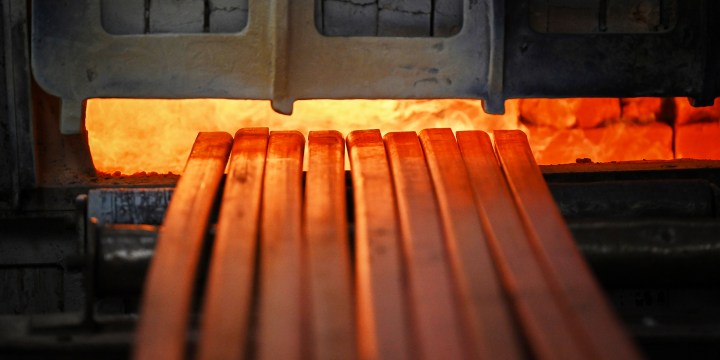BUSINESS REFLECTION
Loaded for Bear: A lot of old metals are now ‘green’, and that’s not a bad thing

If you’re a mining company, the best way to market your product or attract investors is to find a new use for it in the green energy transition. This applies to metals that humans have used for thousands of years.
Copper is one of the oldest metals that humans have utilised. Around 10,000 years ago, our ancestors stumbled on to the fact that the metal could be forged into tools or weapons more easily than old-fashioned stones.
The rest, as they say, is history.
The next steps included the rise of metallurgy and technological advances that eventually took off at an accelerating pace.
Fast-forward a few thousand years and one finds that copper was crucial to the industrial revolution.
“No copper, no industrial revolution,” in the words of Daniel Cunha, a leading scholar on the subject.
From sugar production to the slave trade to steam ships and the telegraph, and a whole lot in between, Cunha maintains that “copper was conspicuous”.
In a more recent example of industrialisation, copper has been a critical component in China’s super-charged growth into a global economic giant.
So copper has played a key role in the rise of the Anthropocene – the current epoch that speaks bluntly to humanity’s impact on the global environment – and the fact that our planet is now burning in the face of rapid climate change.
But lo and behold, the red metal has now donned a green sheen.
Copper is now classified as a “green metal” because of its use in wind, hydro and solar energy technologies as well electric vehicles.
Another example is silver. It has been used as a store of wealth and as a currency for thousands of years – in French argent means both silver and money.
Silver also fuelled the Spanish conquest of the Americas in the 16th and 17th centuries, an episode in history that resulted in the deaths of millions of Amerindians and ecological devastation on a grand scale.
New lease on life for old metal
But the white metal is also, well, green. It is used in the solar cells that produce electricity, a function that is giving this old metal a new lease on life.
Or take tin, which most people associate with cans. Its main use is actually for soldering circuit boards.
But Alphamin Resources, which mines the world’s richest tin deposit in the DRC, maintains that: “Tin is the metal with which the fourth industrial revolution will be built.”
“… tin will be the material of choice for the next generation of energy-generating and -storage devices whilst being the ‘glue’ that holds all of these components together. This will make tin a vital component in the manufacturing of electric vehicles, advanced robotics, renewable energies, and advanced computing,” Alphamin says, citing researchers from the Massachusetts Institute for Technology.
Tin’s potential role in the green energy transition and the road to net-zero emissions has been highlighted by analysts, including energy consultancy Wood Mackenzie.
Nickel is another metal undergoing a paint job. Its industrial roles really took off in the 20th century with its applications in jet engine technology and the making of stainless steel.
It is also now vital for the production of the cathode material of the lithium-ion batteries that power electric vehicles.
There are also emerging uses on the renewable energy front for metals that have already had green uses for decades.
Platinum group metals (PGMs) have long been associated with the catalytic converters in automobiles that cap the emissions of the internal combustion engine.
This technology was developed by Johnson Matthey in response to the US Clean Air Act of 1970, which itself was a response to growing concerns about pollution and the environment, a point underscored by the estimated 20 million people who took part in Earth Day events across America that same year.
PGMs are now finding a role in the energy transition as the internal combustion engine looks set to gradually get phased out, though probably not at the pace that was assumed just a couple of years ago.
Rhodium and platinum are both part of the mix for the alloy used to make fibreglass, which in turn is crucial to wind turbines. As South African PGM producers recently learnt, a crash in the price of rhodium stemmed largely from a secretive switch by Chinese fibreglass makers to using less of the metal in the alloy, which three years ago was fetching $30,000 an ounce.
Platinum is also seen as critical to the nascent hydrogen economy.
These are just a few examples, but they point to the direction in which the winds of metal demand are tilting.
A sceptic might note a heavy dose of green-washing at work here, and there may be some truth to that.
But these trends – and the chemists and other scientists driving them – should surely be applauded.
If a metal is required for the changes in energy sources needed to contain the rising temperatures linked to the use of fossil fuels – and it can be extracted with minimal environmental disturbance – then it must be mined, finish and klaar.
If something as unexpected as tin can have a green use, that needs to be utilised.
And you can bet your bottom dollar that there is a lot of research currently being applied to unlock the green secrets that metals of all shades still contain.
It’s also the case that while many of the old uses of these metals have contributed to environmental damage including climate change, they also laid the foundation for the modern world and rising living standards.
The environment in developed economies is often in a better state than in developing economies, not least because affluent, middle-class societies have the time and resources to worry about such things.
The industrial sword fashioned from these metals has been double-edged.
One big loser in the current race is obviously coal. There is some hype around the concept of “clean coal” and carbon capture technology, but many experts see this as a costly distraction.
Coating coal with a green sheen is akin to painting lipstick on a pig.
As a result, the coal sector is gradually being deprived of capital as a growing number of banks stop providing it with finance. Demand for the fossil fuel reached a record high last year, but the International Energy Agency forecasts that it will steadily descend from that peak
Meanwhile, if a company can find a new green application for the metal it is mining, it will have struck gold. DM

















 Become an Insider
Become an Insider
Mxm